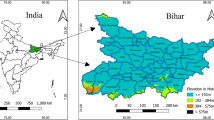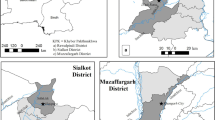Abstract
China suffers frequent and severe floods. A lot of studies have been done in the field of flood disaster, including flood vulnerability assessment. This paper develops assessment models of multidimensional flood vulnerability based on the data envelopment analysis method and identifies multidimensional flood vulnerability—population, death, agriculture and economy—at the provincial scale in China using flood damage data and socioeconomic statistical data from 2001 to 2010. Based on the characteristics of multidimensional flood vulnerability of each province, some suggestions for flood prevention and mitigation are suggested. The assessment models of multidimensional flood vulnerability are simple and can be used for vulnerability analysis of natural disaster at regional or national levels. The assessment of multidimensional flood vulnerability can provide multifaceted information that contributes to a deeper understanding of the flood vulnerability and provides a scientific base for the policy making and implementation of flood prevention and mitigation designs.




Similar content being viewed by others
References
Abbott M, Doucouliagos C (2003) The efficiency of Australian universities: a data envelopment analysis. Econ Educt Rev 22(1):89–97
Balica SF, Wright NG (2010) Reducing the complexity of the flood vulnerability index. Environ Hazards 9(4):321–339
Brockett PL, Charnes A, Cooper WW et al (1997) Data transformations in DEA cone ratio envelopment approaches for monitoring bank performances. Eur J Oper Res 98(2):250–268
Brockett PL, Cooper WW, Shin HC et al (1998) Inefficiency and congestion in Chinese production before and after the 1978 economic reforms. Socio-Econ Plan Sci 32(1):1–20
Büchele B, Kreibich H, Kron A et al (2006) Flood-risk mapping: contributions towards an enhanced assessment of extreme events and associated risks. Nat Hazards Earth Syst Sci 6(4):485–503
Charnes A, Cooper WW, Rhodes E (1978) Measuring the efficiency of decision making units. Eur J Oper Res 2(6):429–444
Clark GE, Moser SC, Ratick SJ et al (1998) Assesing the vulnerability of coastal communities to extreme storms: the case of revere, MA, USA. Mitig Adapt Strat Glob Chang 3:59–82
Connor RF, Hiroki K (2005) Development of a method for assessing flood vulnerability. Water Sci Technol 51(5):61–67
Cooper WW, Seiford LM, Zhu J (2011) Data envelopment analysis—history, models and interpretations. In: Cooper WW, Seiford LM, Zhu J (eds) Handbook on data envelopment analysis, 2nd edition, international series in operations research & management science, 2nd edn. Springer, New York, pp 1–39
Dilley M, Chen RS, Deichmann U et al (2005) Natural disaster hotspots: a global risk analysis. The World Bank, Hazard Management Unit, Washington, DC
Downton MW, Pielke RA Jr (2005) How accurate are disaster loss data? the case of U.S. flood damage. Nat Hazards 35(2):211–228
Dutta D, Herath S, Musiake K (2003) A mathematical model for flood loss estimation. J Hydrol 277(1):24–49
Experian Limited (2000) Great Britain MOSAIC descriptions along with separate data tables for flood damage. Experian, Nottingham
Ganoulis J (2009) An integrated approach for flood risk management. In: Linkov I, Ferguson EA, Magar VS et al (eds) Real-time and deliberative decision making. NATO science for peace and security series C: environmental security. Springer, Dordrecht, Berlin, pp 91–101
Gao JX, Nickum JE, Pan YZ (2007) An assessment of flood hazard vulnerability in the dongting lake Region of China. Lakes Reserv Res Manag 12(1):27–34
Hall JW, Sayers PB, Dawson RJ (2005) National-scale assessment of current and future flood risk in England and Wales. Nat Hazards 36(1–2):147–164
Hollingsworth B, Dawson PJ, Maniadakis N (1999) Efficiency measurement of health care: a review of non-parametric methods and applications. Health Care Manag Sci 2(3):161–172
Huang DP, Liu C, Peng SF (2007) Progress on assessment and regionalization of flood risk. Prog Geogr 26(4):11–22 (in Chinese)
Huang DP, Liu C, Fang HJ et al (2008) Assessment of waterlogging risk in Lixiahe region of Jiangsu Province based on AVHRR and MODIS image. Chin Geogr Sci 18(2):178–183
Huang ZW, Zhou JZ, Song LX et al (2010) Flood disaster loss comprehensive evaluation model based on optimization support vectormachine. Expert Syst Appl 37(5):3810–3814
Jiang WG, Deng L, Chen LY et al (2009) Risk assessment and validation of flood disaster based on fuzzy mathematics. Prog Nat Sci 19(10):1419–1425
Liu LF, Zou J, Liu XN (2002) Assessment and analysis of the vulnerability of agricultural flood-waterlogging disaster—a case study of Hengyang, Hunan. Resour Environ Yangtze Basin 11(3):291–295 (in Chinese)
Liu Y, Huang JY, Ma L (2010) The assessment of regional vulnerability to natural disasters in China based on DEA model. Geogr Res 29(7):1153–1162 (in Chinese)
Ma DG, Liu Y, Chen J et al (2007) Farmer’s vulnerability to flooding in the Poyang Lake region. Acta Geogr Sinica 62(3):321–332 (in Chinese)
Messner F, Meyer V (2006) Flood damage, vulnerability and risk perception–challenges for flood damage research. In: Schanze J, Zeman E, Marsalek J (eds) Flood risk management—hazards, vulnerability and mitigation measures, Nato Science Series IV. Springer, Dordrecht, pp 149–167
Penning-Rowsell EC, Johnson C, Tunstall SM et al (2003) The benefits of flood and coastal defence: techniques and data for 2003. Middlesex University Flood Hazard Research Centre, London
Plate EJ (2002) Flood risk and flood management. J Hydrol 267(1–2):2–11
Ratick SJ, Osleeb (2011) Measuring the vulnerability of populations susceptible to lead contamination in the Dominican Republic: evaluating composite index construction methods. GeoJournal. doi:10.1007/s10708-011-9414-x
State Flood Control & Drought Relief Headquarters (2002) Flood damages of 2001 in China. China Flood Drought Manag 12(1):61–64 (in Chinese)
State Flood Control & Drought Relief Headquarters (2004) Flood damages of 2003 in China. China Flood Drought Manag 14(1):55–59 (in Chinese)
State Flood Control & Drought Relief Headquarters (2005) Flood damages of 2004 in China. China Flood Drought Manag 15(1):48–53 (in Chinese)
State Flood Control & Drought Relief Headquarters (2006) Flood damages of 2005 in China. China Flood Drought Manag 16(1):55–60 (in Chinese)
State Flood Control & Drought Relief Headquarters, Ministry of water resources of the PRC (2011a) Bulletin of flood and drought disasters in China 2009. http://www.mwr.gov.cn/zwzc/hygb/zgshzhgb/201103/t20110301_255427.html. Accessed 1 October 2011
State Flood Control & Drought Relief Headquarters, Ministry of water resources of the PRC (2011b) Bulletin of flood and drought disasters in China 2010. http://www.mwr.gov.cn/zwzc/hygb/zgshzhgb/201110/t20111013_306570.html. Accessed 1 October 2011
Takamura T, Tone K (2003) A comparative site evaluation study for relocating Japanese government agencies out of Tokyo. Socio-Econ Plan Sci 37(2):85–102
Tapsell SM, Penning-Rowsell EC, Tunstall SM et al (2002) Vulnerability to flooding: health and social dimensions. Philos Trans R Soc Lond A 360:1511–1525
Wei YM, Jin JL, Yang CJ et al (2002) Theory of risk management of flood disaster. Science Press, Beijing (in Chinese)
Wei YM, Ying F, Cong L et al (2004) The assessment of vulnerability to natural disasters in China by using the DEA method. Envrion Impact Assess Rev 24(4):427–439
Xu J (2003) Flood damages of 2002 in China. China Flood Drought Manag 13(1):54–58 (in Chinese)
Xu J (2007) Flood damages of 2006 in China. China Flood Drought Manag 17(1):46–53 (in Chinese)
Yan SC (2009) Flood damages of 2008 in China. China Flood Drought Manag 19(1):60–67 (in Chinese)
Zhang BW (2008) Flood damages of 2007 in China. China Flood Drought Manag 18(1):59–65 (in Chinese)
Zhu J (2000) Multi-factor performance measure model with an application to Fortune 500 companies. Eur J Oper Res 123(1):105–124
Zhu CH, Li RD (2005) Analysis on changes of the vulnerability of flood-waterlogging disaster in Dong-ting Lake area. J Cent China Norm Univ (Nat Sci) 39(2):283–286
Acknowledgments
This work was jointly funded by National Science & Technology Pillar Program of China during the Eleventh Five-Year Plan Period (Grant No. 2008BAK50B02) and National Natural Science Foundation of China (Grant No. 41101517 and Grant No. 40901231). We are grateful to Richard Becker, of the department of geoscience, University of Wisconsin-Madison, for his help in editing the paper. Last but not the least, cordial thanks are extended to the editor-in-chief, Prof. Dr. Thomas Glade, and two anonymous reviewers for their professional comments that greatly improved the quality of this paper.
Author information
Authors and Affiliations
Corresponding author
Rights and permissions
About this article
Cite this article
Huang, D., Zhang, R., Huo, Z. et al. An assessment of multidimensional flood vulnerability at the provincial scale in China based on the DEA method. Nat Hazards 64, 1575–1586 (2012). https://doi.org/10.1007/s11069-012-0323-1
Received:
Accepted:
Published:
Issue Date:
DOI: https://doi.org/10.1007/s11069-012-0323-1




